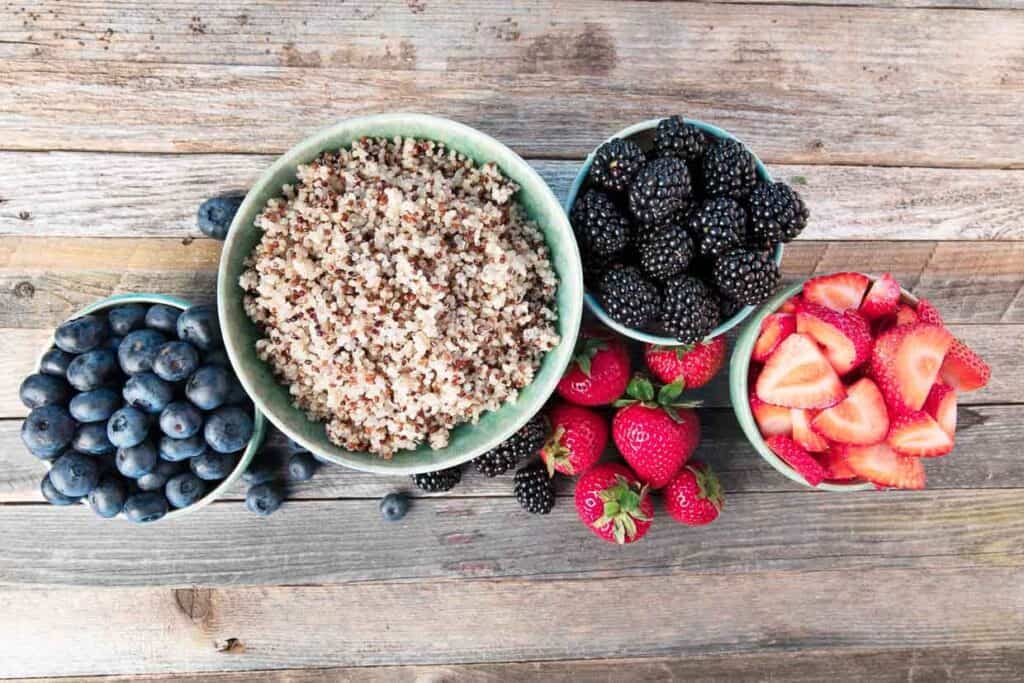Quinoa is a highly nutritious grain that has recently gained significant popularity. It boasts exceptional health benefits and versatility in cooking. Originally from the Andean region of South America, quinoa has been cultivated for thousands of years and thrives in various climates.

It’s not a true cereal grain but rather a pseudocereal. It’s not grass but a seed from a plant related to spinach, sugar beets and beets. The leaves can be prepared and enjoyed like spinach, making this plant a source of valuable seeds and a versatile green vegetable in its own right.
If you’re wondering how to pronounce quinoa, don’t worry; it’s a commonly asked question. The answer is simply keen-wah. It’s so easy it probably throws some people off.
Quinoa’s health benefits
Quinoa has many healthy attributes. Here are some of the standout nutritional facts about this seed.
- Complete protein: Quinoa is one of the few plant foods that contain all nine essential amino acids, making it an excellent protein source for vegetarians and vegans. It’s so tasty everyone will enjoy it.
- Fiber: It is high in fiber compared to most grains, contributing to better digestive health. It can also help reduce the risk of heart disease and help with weight management because of its fiber content.
- Vitamins and minerals: Quinoa is rich in various vitamins and minerals. These include but are not limited to magnesium, iron, B vitamins, potassium, calcium, phosphorus and vitamin E.
- Antioxidants: It contains more antioxidants than many other grains, which help combat oxidative stress and inflammation in the body.
“I love quinoa because it is so versatile. It can be as simple as cooking it and stirring in some baby spinach and parmesan for a quick side dish or using it in place of other proteins for a main dish, from quinoa burgers to a skillet meal. It really works with so many different flavors and styles of cooking.”
— Michelle Price, Honest and Truly

Why it’s beloved in the kitchen
There are many reasons to love cooking with quinoa beyond its role as a tasty vegetarian and vegan protein.
- Gluten-free: Quinoa is naturally gluten-free, making it a fantastic option for people with celiac disease or gluten sensitivities.
- Versatile ingredient: You can use it in various dishes, from quinoa salads and soups to pilafs, breakfast porridges and baked goods.
- Cooking: Quinoa is cooked similarly to rice, with a general ratio of two parts water to one part quinoa. It has a slightly nutty flavor and a fluffy, slightly crunchy texture. One cooking note: be sure to thoroughly rinse quinoa in a sieve before using it. Rinsing removes the bitter saponins the seeds are covered with.
Consider adding a warm quinoa dish to a vegetarian meal to round it out. Or make a salad with it and serve alongside any meal. No one will even know what kind of nutritious powerhouse they’re enjoying or how good it is for them.
“I love using quinoa when I make plant-based salads, soups or bowls to add a little extra plant protein and fiber to my meals. It’s easy to make ahead of time and pull out when I need to use it for a quick protein boost.”
— Cindy Rainey, Veggie Fun Kitchen

Sustainability
Quinoa’s sustainability lies in its remarkable resilience to harsh growing conditions. It can grow in poor soil, at high altitudes and during droughts. It requires far less water than many crops, making it accessible to many worldwide. The adaptability of quinoa reduces the need for artificial irrigation and fertilizers, making this a sustainable choice for future food security and environmental conservation.
Cultural significance
Quinoa, termed the mother of all grains, was a staple food for the Inca civilization. Its cultivation has spread globally, but Bolivia and Peru remain the largest producers and exporters. This enduring legacy highlights quinoa’s timeless value and its role in bridging past traditions with modern culinary practices worldwide.
This super seed is more than a trendy health food or vegan choice. It’s a sustainable, versatile and nutritious seed that benefits the environment and your health. With its rich history, robust nutritional profile and ease of incorporation into various dishes, quinoa has rightfully earned its place in kitchens worldwide.
Whether you’re looking to enhance your diet with a complete protein source, seeking gluten-free alternatives or exploring sustainable eating options, quinoa presents a compelling choice. Its cultural significance and adaptability to harsh growing conditions underscore its potential as a key ingredient in the global quest for food security.
Laura Sampson of Little House Big Alaska is on a mission to teach modern family-oriented home cooks how to make old-fashioned foods new again. She shares her passion for home cooking, backyard gardening and homesteading on her website and blog.